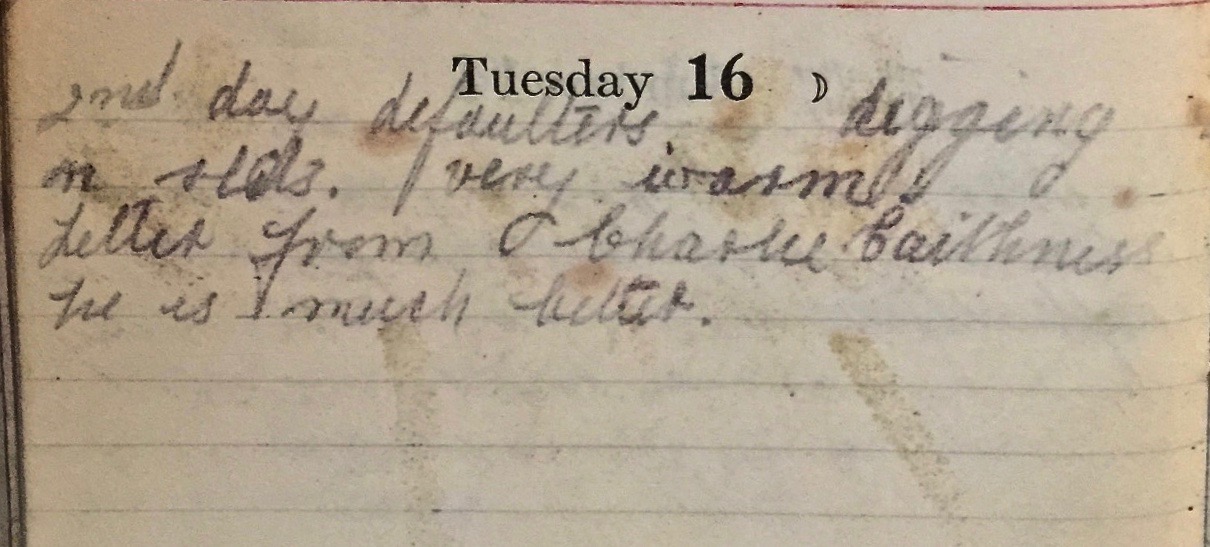Tuesday July 16th, 1918
Second day defaulters. Digging on slits. Very warm. Letter from Charlie Caithness. He is much better.
Good News?
Caithness has been suffering from malaria and the last time Frank saw him he was being evacuated to one of the hospitals in Salonika. Only problem is that in this entry Frank calls him Charlie and I thought he was called Thomas. I cannot find a Charles Caithness in the Manchesters – any ideas welcome!
Innovations in Warfare
A few days ago, an international force of Australians, Americans and British, under the command of General Monash, fought and won the small but strategic Battle of Hamel. General Monash, widely regarded as one of the best and most innovative commanders on the Western Front, used both tanks and parachutes to deliver supplies to the advancing troops. ‘The supply tanks and aircraft brought stores quickly to the troops as they advanced. The carrying power of the tanks equated to about 1,200 troops doing the same job.‘¹
Today, by contrast, the 13th has drawn horses and mules to support its transportation needs.
In the early days of tanks, they had a mixed reputation with both men and their commanders. In advance of the battle therefore considerable effort was expended to make the men more comfortable. ‘Five companies (60 combat and four supply tanks) of the British 5th Tank Brigade were provided for the assault. Although the Australians had worked with a small number of tanks successfully at Villers-Bretonneux, their opinion of the technology was clouded by the bad experience they had had of them in April and May 1917 around Bullecourt. As such, to ensure co-ordination and overcome the problems the Australians had experienced at Bullecourt, the Australian infantry and tanks trained and lived together prior to the battle. Coloured diagrams were painted on the sides of the tanks, corresponding to the battalions that they would support, so that the infantry knew which tank to follow.’¹
A Modern General John Monash (1865-1931)

In civilian life, John Monash was a civil engineer and businessman. In war, he was, and remains, the most famous and lauded Australian commander.
His family, German Jews, had emigrated to Australia shortly before his birth. Recognized early as academically gifted, the family had moved to Melbourne to allow John to flourish. He studied at the University of Melbourne gaining degrees in both Engineering and Law. He joined the militia while at University and by 1912 was commander of the 13th Infantry Brigade of the Australian Army Reserves. Mobilizing at the outbreak of war, he was soon appointed commander of the 4th Brigade of the Australian Imperial Force. Initially in Egypt and then at Gallipoli, where his Brigade lost almost two thirds of its men, he was recognized for his organizational ability and promoted to Brigadier General.
In July 1916, shortly after moving to the Western Front, Monash, now a Major General, was made commander of the Australian 3rd Division. They were involved in many actions, including Messines and the First Battle of Passchendaele. In May 1918, he was promoted to command the Australian Corps.
Battlefield Honours
The Battle of Hamel was followed by the more significant and decisive Battle of Amiens, launched on August 8th, 1918. Led by General Rawlinson’s British 4th Army, consisting of the Australian Corps under Monash, the Canadian Corps under Arthur Currie, and the British III Corps, this battle signalled the beginning of the end of the war. Ludendorff later wrote of it, “August 8th was the black day of the German Army in the history of the war”.
In recognition of his role and that of the Australian Corps, Monash was knighted, on the battlefield of Amiens, by King George V – the first time a commander had been honoured in such a way in over 200 years.
After the war, General Monash, returning to civilian life, was instrumental in establishing Anzac Day. When he died of an heart attack in 1931 he was awarded a state funeral. It was attended by over 300,000 mourners.
13th (Service) Battalion War Diary – 16th July 1918 – Abancourt, France
Training Programme issued (Appendix No 1). Companies training as programme. 4 OR on leave. Regt transport drawn 6 light draught horses, remainder mules, only two chargers.
References & Further Reading
¹ Battle of Hamel on Wikipedia
² General John Monash on Wikipedia
* photograph of General Monash, public domain


